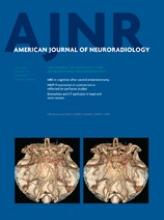Abstract
BACKGROUND AND PURPOSE: Men have a greater prevalence of high-risk carotid plaque features associated with stroke compared with women who have ≥50% stenosis, but little is known about these features in less significantly stenotic carotid arteries. This study aims to evaluate sex differences in complicated carotid plaque features in asymptomatic patients with <50% stenosis.
MATERIALS AND METHODS: Ninety-six patients (50 men, 46 women) with <50% carotid stenosis on MRA who had been referred for analysis of contralateral >50% carotid stenosis were included. The associations between sex and plaque features as identified by 3T MR carotid plaque imaging were examined by using logistic and linear regression models controlling for demographic characteristics, MRA stenosis, and the presence of contralateral plaque features.
RESULTS: The presence of a thin/ruptured fibrous cap (16% versus 2%, adjusted odds ratio = 8.57, P = .047), IPH (24% versus 6%, adjusted odds ratio = 4.53, P = .027), and American Heart Association type VI plaque (26% versus 6%, adjusted odds ratio = 5.04, P = .017) was significantly higher in men than in women. These associations remained significant following adjustment for contralateral plaque features. Men demonstrated a larger percentage volume of LR/NC (median, 1.66% versus −0.21%; P < .01). Calcification was not significantly associated with sex.
CONCLUSIONS: There is a sex difference of higher risk carotid plaque features during the early stage of disease seen in patients recruited for MR imaging evaluation of contralateral moderate-to-severe stenosis. Given the potential of using LR/NC without or with IPH to monitor therapy, these results indicate the possible importance of sex-based management in patients with asymptomatic carotid atherosclerosis across all stages of carotid stenosis.
ABBREVIATIONS:
- CE
- contrast-enhanced
- IPH
- intraplaque hemorrhage
- IR-FSPGR
- inversion recovery fast spoiled gradient echo
- LR/NC
- lipid-rich necrotic core
- TOF
- time-of-flight
- © 2013 by American Journal of Neuroradiology
Indicates open access to non-subscribers at www.ajnr.org












